Ski Racing is a Marathon, Not a Sprint
Fall is an exciting time of year for ski racers. It is also a very expensive time of year, as gear, lift passes, race licenses, ski house leases, and all the pieces that go into a year of ski racing all come together and hit your bank account at the same time. The sticker shock is enough to make even the most devoted of ski racing families pause to ask themselves: “Can we keep doing this?”
Too often, that question becomes urgent before it needs to. The arms race of chasing top-level equipment and training seems to be creeping into younger age classes each year. Finite resources that could be spent supporting basic skills and a love for the sport are instead spent on multiple pairs of skis, offseason training camps in faraway lands and fancy wax. At each stage of youth skiing, where should you spend and where can you save? Here is what the pros say.
THE CLUB
When kids start racing the name of the game is to keep it fun and build basic skills. It’s important to put kids in a program where they have friends and spend lots of time on snow having fun in all conditions. If your home area is small, occasional trips to bigger mountains where kids can find interesting and challenging terrain are worthy splurges. But there’s no need to haul the family on long car rides each weekend simply to get to a larger resort if you have a suitable one closer to home.
THE GEAR
This one is a biggie. Former U.S. Ski Team downhiller Adele Savaria and her husband Pat, both longtime coaches at Sun Valley, often advise parents that they don’t need to keep up with the Joneses for their kids to be successful. The right gear is far more important than the most gear. Terry Delliquadri, head U14 coach at Ski & Snowboard Club Vail, echoes Savaria, and notes that used ski equipment can be a boon to a young skier. Many programs, Vail included, recycle gear within the club and host preseason ski swaps. Consider shopping and asking around before splurging on brand new gear each and every season.
BOOTS
At every level, well-fitting boots are critical. Particularly at younger ages, the boots need to be soft enough to flex and allow kids to both use their ankles in the turn and feel the entire ski. Tracy Gibbons, former U.S. Ski Team athlete, manager of Sturtevants Sports in Seattle, and U14 racer mom says, “A good fitting two-year-old race boot is better than an ill-fitting new race boot that an athlete can ‘grow into’.” Gibbons is also a strong advocate for footbeds, even before kids’ feet stop growing. “They can cost less than a daily lift ticket and provide comfort and a solid platform for performance.” (Stay tuned for more specifics on footbeds in a upcoming Backshop article here on SkiRacing.com).
SKIS
Savaria, now a U12 coach, raised two ski racer sons all the way through the U19 age class without breaking the bank. Her advice to parents on ski needs for their children is frugal but effective.
U10:
An in-between ski – GS ski with a slalom sidecut – is totally doable for all the races, which should not be many!
U12:
One pair of slalom and one pair of GS skis should be enough. The limiting factor is the amount of edge, which depends on how much your child skis and how icy the conditions are in your area.
U14:
One pair of slalom and one pair of GS is still doable at this age. Also, it’s a good idea to hang onto a pair of old skis from the previous winter for free skiing in the beginning of the season or off the beaten track. This is the age at which kids typically get their first taste of speed events, in super-G. Delliquadri adds: Find a pair of used women’s FIS GS skis which will be the correct radius for U14s and also less expensive.
*Speed ski note: It makes little sense at this age to purchase a new super-G setup which may only be used two or three times in a season. Many programs keep a stable of used speed skis that kids can borrow for those first speed experiences. For all age levels, “Good speed skis last a long time and get faster with use,” notes Delliquadri.
U16:
Two pairs of slalom skis and two pairs of GS. Depending on how much they will train for and race super-G, athletes may still be able to borrow those skis and can certainly find good used ones.
U19/FIS:
At this level, the ramped up costs – for equipment and travel – are unavoidable for athletes hoping to progress at the top level. USSA athletes need two slalom, two GS, one super-G and possibly even one pair of downhill skis. FIS athletes who ski in more speed races may need to add SG and DH training skis to the quiver as well. This is also an age at which many athletes headed to college are shedding their speed skis, so be on the lookout for a deal from someone who’s decided to go all tech.
SUITS/HELMETS/GOGGLES
A shiny new suit is dreamy, but so is a suit with a storied past. There is no shame in the hand-me-down suit, at any age, and especially when delving into FIS-legal gear. Look at swaps, on bulletin boards in your club, or even reach out to past club members who have been named to national or collegiate teams to see if they are trying to sell any old suits.
Helmets are protective gear – no skimping here because you never know the quality of a used helmet. Goggles are shockingly expensive, but good vision is essential. Make sure you have appropriate lenses for all weather conditions, especially low light. Teach kids from a young age to protect their goggles by always storing them in the bag provided. Having trouble with compliance? Make them buy their own lenses once. That’ll work.
PREPPING AND PRESERVING YOUR GEAR
Sadly, skis right out of the box are rarely set to jet. They may be railed (edge high), overly beveled (base high), or uneven. Paying for a good initial grind or hand tune, from a trusted and experienced shop, is a wise investment. Eric Harlow, alpine program director at Sugar Bowl, puts it this way, “You’re better off ski racing in a pair of jeans on skis that are tuned perfectly than you are skiing in the fastest GS suit with the fastest wax on a pair of skis that have a two-degree base bevel.” Once skis are set up well, all it should take is regular, vigilant touch-ups to maintain sharp edges and smooth bases.
Savaria advocates teaching kids about basic ski prep starting at the U12 level. “We usually have one tuning clinic to show them the process and then they try it on a pair of our coaches’ skis just to start learning.” As kids get more familiar with tuning equipment and methods, they can be responsible for maintaining their own skis. When it comes to waxes, expensive fluoros might make a difference on the extreme margins, but they will never trump good ski technique.
IN SEASON TRAINING
Delliquadri and Harlow both stress that the best way to stretch your dollars for time on snow is simply to make the most out of each on-snow session and each day of skiing. “Ski locally where there is local snow,” says Delliquadri. In the West that means skiing into May at mountains that are still open. In the East, make November day or weekend trips to places like Killington or resorts in Quebec where the guns fire up early.
Set priorities and make choices: If skiing means a lot to you, don’t use potential on-snow time training for indoor sports. Get out early and ski until the lifts close. Over the course of a season, this adds up. As Delliquadri says, “You don’t need to spend thousands of dollars to ski in the summer if you are getting it done during the season.”
As with equipment, at the FIS level the price tag to stay competitive goes up. “Travel and training-wise, at this level you need to be ready to compete in November,” says Delliquadri, “and that means substantial on-snow training in the offseason.” Delliquadri, who was a four-year All-American at Dartmouth College, points out that collegiate skiing can be a sensible path: “Competing for a college where athletic expenses are paid seems like a good financial decision.”
COMPETITION
You don’t need to do it all! Believe me. For younger kids, time is better spent skiing and acquiring skills than it is on racing. Race days are great opportunities to learn how to compete and also to ski a new mountain, but the number of runs kids take on race days is usually significantly less than during a day of training. As kids get a little older, it can seem like every race is a qualifier for some higher level of competition, when none of the results through the U16 level really matter in the long run. Time is better spent training at home with repetition and mileage than chasing races all over the region.
At the FIS level, every race and race series is an investment in time and money. Coaches and athletes need to make a plan in the preseason with specific goals that include the maximum number of races, and then adjust according to fitness, fatigue, injury, conditions, field quality and size, and whatever else fate and Mother Nature throw your way.























